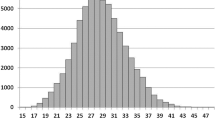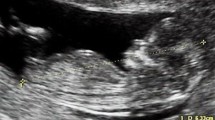Abstract
The first trimester screening programme offers a noninvasive option for the early detection of aneuploidy pregnancies. This screening is done by a combination of two biochemical markers i.e. serum free β-human chorionic gonadotrophin (free β-hCG) and pregnancy associated plasma protein A (PAPP-A), maternal age and fetal nuchal translucency (NT) thickness at 11 + 0–13 + 6 weeks of gestation. A beneficial consequence of screening is the early diagnosis or trisomies 21, 18 and 13. At 11 + 0–13 + 6 weeks, the relative prevalence of trisomies 18 and 13 to trisomy 21 are found to be one to three and one to seven, respectively. All three trisomies are associated with increased maternal age, increased fetal NT and decreased PAPP-A, but in trisomy 21 serum free β-hCG is increased whereas in trisomies 18 and 13 free β-hCG is decreased.







Similar content being viewed by others
References
Snijders RJM, Sundberg K, Holzgreve W, Henry G, Nicolaides KH. Maternal age- and gestation-specific risk for trisomy 21. Ultrasound Obstet Gynecol. 1999;13:167–70.
Wilson RD. Amended Canadian Guideline for prenatal diagnosis (2005) change to 2005—techniques for prenatal diagnosis. SOGC Clinical Practice Guidelines, No. 168, November 2005. J Obstet Gynaecol Can. 2005;27:1048–54.
Bindra R, Liao VHA, Spencer K, Nicolaides KH. One stop clinic for assessment of risk for trisomy 21 at 11–14 weeks: a prospective study of 15030 pregnancies. Ultrasound Obstet Gynecol. 2002;20:219–25.
Nicolaides KH. Screening for fetal aneuploides at 11 to 13 weeks. Prenat Diagn. 2011;1(31):7–15.
Dugoff L, Hobbins JC, Malone FD, et al. Quad screen as a predictor of adverse pregnancy outcome. Obstet Gynecol. 2005;106:260–7.
Nicholas JW, Wayne JH, Allan KH. Antenatal screening for Down’s syndrome with the quadruple test. Lancet. 2003;361(9360):835–6.
Wald NJ, Kennard A, Hackshaw A, McGuire A. Antenatal screening for Down’s syndrome published erratum appears in. J Med Screen. 1998;5:110.
Petrovic I, Marina D, Juan CK. The role of pregnancy associated plasma protein –A (PAPP-A) in the identification of coronary artery disease activity. Acta Fac Med Naissensis. 2007;24(4):183–8.
Fialova L, Malbohan IM. Pregnancy-associated plasma protein-A (PAPP-A): theoretical and clinical aspects. Bratisl Lek Listy. 2002;103:194–205.
Overgaard MT, Oxvig C, Christiansen M, Lawrence JB, Conover CA, Gleich GJ. Messenger ribonucleic acid levels of pregnancy-associated plasma protein-A and the proform of eosinophil major basic protein: expression in human reproductive and non reproductive tissues. Biol Reprod. 1999;61:1083–9.
Overgaard MT, Boldt HT, Laursen LS, Sottrup-Jensen L, Conover CA, Oxvig C. Pregnancy-associated plasma protein-A2 (PAPP-A2), a novel insulin-like growth factor-binding protein-5 proteinase. J Biol Chem. 2001;276:21849–53.
Qin Q-P, Kokkala S, Lund J, Tamm N, Voipio-Pulkki LM, Pettersson K. Molecular distinction of circulating pregnancy-associated plasma protein-A in myocardial infarction and pregnancy. Clin Chem. 2005;51:75–83.
Overgaard MT, Sorensen ES, Stachowiak D, Boldt HB, Kristensen L, Sottrup-Jensen L, et al. Complex of pregnancy-associated plasma protein-A and the proform of eosinophil major basic protein disulfide structure and carbohydrate attachment sites. J Biol Chem. 2003;278:2106–17.
Oxvig C, Sand O, Kristensen T, Kristensen L, Sottrup-Jensen L. Isolation and characterization of circulating complex between human pregnancy-associated plasma protein-A and proform of eosinophil major basic protein. Biochim Biophys Acta. 1994;1201:415–23.
Oxvig C, Haaning J, Hojrup P, Sottrup-Jensen L. Location and nature of carbohydrate groups in proform of human major basic protein isolated from pregnancy serum. Biochem Mol Biol Int. 1994;33:329–36.
Handschuh K, Guibourdenche J, Guesnon M, Laurendeau I, Evain-Brion D, Fournier T. Modulation of PAPP-A expression by PPARgamma in human first trimester trophoblast. Placenta. 2006;27(Suppl A):S127–34.
Overgaard MT, Haaning J, Boldt HB, Olsen IM, Laursen LS, Christiansen M, Gleich GJ, et al. Expression of recombinant human pregnancy-associated plasma protein-A and identification of the proform of eosinophil major basic protein as its physiological inhibitor. J Biol Chem. 2000;275(40):31128–33.
Bischof P, DuBerg S, Herrmann W, Sizonenko PC. Pregnancy-associated plasma protein-A (PAPP-A) and hCG in early pregnancy. Br J Obstet Gynaecol. 1981;88:973–5.
Bischof P, Amandruz M, Weil-Franck C, Baeriswyl JP, Weil A, Hermann WL, et al. The disappearance rate of pregnancy-associated plasma protein-A (PAPP-A) after the end of normal and abnormal pregnancies. Arch Gynecol. 1984;236:93–8.
Boldt HB, Conover CA. Pregnancy-associated plasma protein-A (PAPP-A): a local regulator of IGF bioavailability through cleavage of IGFBPs. Growth Horm IGF Res. 2007;17:10–8.
Peterson SE, Simhan HN. First-trimester pregnancy-associated plasma protein A and subsequent abnormalities of fetal growth. Am J Obstet Gynecol. 2008;198(5):43–5.
Gagnon A, Douglas RW. Obstetrical complications associated with abnormal maternal serum markers analytes. J Obstet Gynaecol Can. 2008;30(10):918–32.
Santolaya-Forgas I, Leon JAD, Cullen Hopkins R, Castracane VD, Kauffman RP, Sifuentes GP. Low pregnancy-associated plasma protein-A at 10 + 1 to 14 + 6 weeks of gestation and a possible mechanism leading to miscarriage. Fetal Diagn Ther. 2004;19:456–61.
Brizot ML, Hyett JA, Mckie AT, Bersinger NA, Farzaneh F, Nicolaides KH. Gene expression of human pregnancy-associated plasma protein-A in placenta from trisomic pregnancies. Placenta. 1996;17:33–6.
Bogart MH, Pandian MR, Jones OW. Abnormal maternal serum chorionic gonadotropin levels in pregnancies with fetal chromosome abnormalities. Prenat Diagn. 1987;7:623–30.
Banerjee P, Fazleabas AT. Extragonadal actions of chorionic gonadotropin. Rev Endocr Metab Disord. 2011;12(4):323–32.
Ulf-Håkan S, Aila T, Henrik A, Leena V. The classification, functions and clinical use of different isoforms of hCG. Hum Reprod Update. 2006;12(6):769–84.
Trenti T, Aloe R, Cervellin G, Lippi G. Human chorionic gonadotropin in pregnancy diagnostic. Clin Chim Acta. 2011;412(17–18):1515–20.
Fernando MR, Donato D, Felice P. Predictive value of hormone measurements in maternal and fetal complications of pregnancy. Endocrine. 2006;23(2):230–57.
Butler SA, Iles RK. The free monomeric beta subunit of human chorionic gonadotrophin (hCG beta) and the recently identified homodimeric beta–beta subunit (hCG beta beta) both have autocrine growth effects. Tumour Biol. 2004;25:18–23.
Eldar-Geva T, Hochberg A, deGroot N, Weinstein D. High maternal serum chorionic gonadotropin level in Downs’ syndrome pregnancies is caused by elevation of both subunits messenger ribonucleic acid level in trophoblasts. J Clin Endocrinol Metab. 1995;80:3528–31.
Oberweis D, Gillerot Y, Koulischer L, Hustin J, Philippe E. The placenta in trisomy in the last trimester of pregnancy. J Gynecol Obstet Biol Reprod. 1993;12:345–9.
Cowans NJ, Stamatopoulou A, Hellström J, Mäkelä MM, Spencer K. PAPP-A and free ss-hCG stability in first trimester serum using PerkinElmer AutoDELFIA and DELFIA Xpress systems. Prenat Diagn. 2010;30(2):127–32.
Cruz J, Cruz G, Minerkawa R, Mazi N, Nicolaides KH. Effect of temperature on free β-human chorionic gonadotropin and pregnancy-associated plasma protein-A concentration. Ultrasound Obstet Gynecol. 2010;36:141–6.
Schulte-Valentin M, Schindler H. Non-echogenic nuchal oedema as a marker for trisomy 21 screening. Lancet. 1992;339:1053.
Roberts LJ, Bewley S, Mackinson AM, Rodeck CH. First trimester fetal nuchal translucency: problems with screening the general population. J Obstet Gynaecol. 1995;102:381–5.
Karl OK, Dave W, Caalina V, Nerea M, Nicolaides KH. Screening for trisomy 21, 18 and 13 by maternal age, fetal NT, fetal heart rate, free beta hCG and PAPP-A. Hum Reprod. 2008;23(9):1968–75.
Hyett JA, Moscoso G, Nicolaides K. Abnormalities of the heart and great arteries in first trimester chromosomally abnormal fetuses. Am J Med Genet. 1997;69:207–16.
von Kaisenberg CS, Nicolaides KH, Brand-Saberi B. Lymphatic vessel hypoplasia in fetuses with Turner syndrome. Hum Reprod. 1999;14:823–6.
Hyett JA, Sebire NJ, Snijders RJ, Nicolaides KH. Intrauterine lethality of trisomy 21 fetuses with increased nuchal translucency thickness. Ultrasound Obstet Gynecol. 1996;7:101–3.
Khalil Asma, Pandya Pranav. Screening for Down syndrome. J Obstet Gynecol India. 2006;56(3):205–11.
Spencer K, Heath V, El-Sheikhah A, Ong CYT, Nicolaides KH. Ethnicity and need for correction of biochemical and ultrasound markers of chromosomal anomalies in the first trimester: a study of oriental Asian and Afro-Caribbean population. Prenat Diagn. 2005;25:365–9.
Kagan KO, Wright D, Spencer K, Molina FS, Nicolaides KH. First-trimester screening for trisomy 21 by free beta-human chorionic gonadotropin and pregnancy-associated plasma protein-A: impact of maternal and pregnancy characteristics. Ultrasound Obstet Gynecol. 2008;31:493–502.
Wright D, Spencer K, Kagan KO, Torring N, Petersen OB, Christou A, et al. First-trimester combined screening for trisomy 21 at 7–14 weeks gestation. Ultrasound Obstet Gynecol. 2010;36:404–11.
Tul N, Spencer K, Noble P, Chan C, Nicolaides KH. Screening for trisomy 18 by fetal nuchal translucency and maternal serum free beta hCG and PAPP-A at 10–14 weeks of gestation. Prenat Diagn. 1999;19:1035–42.
Spencer K, Tul N, Nicolaides KH. Maternal serum free beta hCG and PAPP-A in fetal sex chromosome defects in the first trimester. Prenat Diagn. 2000;20:390–4.
Borrell A, Casals E, Fortuny A, Farre MT, Gonce A, Sanchez A, et al. First-trimester screening for trisomy 21 combining biochemistry and ultrasound at individually optimal gestational ages: an interventional study. Prenat Diagn. 2004;24:541–5.
Kagan KO, Wright D, Baker A, Sahota D, Nicolaides KH. Screening for trisomy 21 by maternal age, fetal nuchal translucency thickness, free beta-human chorionic gonadotropin and pregnancy-associated plasma protein-A. Ultrasound Obstet Gynecol. 2008;31:618–24.
Bernd E, Glaubitz Ralf. First-trimester screening: an overview. J Histochem Cytochem. 2005;53(3):281–3.
Author information
Authors and Affiliations
Corresponding author
Rights and permissions
About this article
Cite this article
Shiefa, S., Amargandhi, M., Bhupendra, J. et al. First Trimester Maternal Serum Screening Using Biochemical Markers PAPP-A and Free β-hCG for Down Syndrome, Patau Syndrome and Edward Syndrome. Ind J Clin Biochem 28, 3–12 (2013). https://doi.org/10.1007/s12291-012-0269-9
Received:
Accepted:
Published:
Issue Date:
DOI: https://doi.org/10.1007/s12291-012-0269-9




